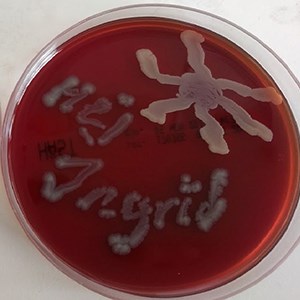Facts:
The project was funded by the Swedish research council Formas and finished during 2020.

The aim of this project was to investigate if there is a functional bacterial community present in milk from healthy dairy cows.
The dairy industry is one of the most important parts of the food production system worldwide and the demand for milk for human consumption is increasing. Selective breeding and improved management have increased milk production per cow in developed countries and in Sweden it has doubled over the last 40 years. There is an unfortunate positive correlation between milk yield and inflammation of the udder, mastitis. Mastitis is the most common disease in dairy cattle, causing the largest economic loss to the industry. Estimates of losses per case of clinical mastitis case varies between €70-520 in European studies and $95-211/cow/year in the United States while subclinical cases cost €60-130 in different studies. It is vital to accurately identify the causative agent to control the disease. Mastitis may occur in a clinical or subclinical (silent) form. Clinical cases can be detected through visible symptoms such as fever, redness, swelling and pain in the udder, and clotting of the milk. Subclinical mastitis, which constitutes the major problem in the mastitis complex of cows, can only be diagnosed with laboratory methods. The most common tool to detect subclinical inflammatory processes in the udder is to determine the concentration of somatic cells (SCC), which typically increases both during subclinical and clinical mastitis.
Many studies based on culturing methods for identification of pathogens in milk clearly show lower and more stable SCC in cows and udder quarters that are culture-negative compared to culture-positive which indicates that culturing generally identifies infections with udder pathogens. Low and stable SCC indicates that no or minor inflammation, and consequently no infection with pathogenic bacteria, is present. Still, the accuracy of these observations may be biased as currently used culture methods are limited in media used and are only optimized for a limited number of bacterial species. For instance anaerobic bacteria are rarely cultured. Negative results on milk from cows with a clinical condition create frustration for dairy producers and veterinarians. Research conducted in the United Kingdom, United States, Canada and Finland has found that 20-30% of milk samples taken from quarters with clinical mastitis will have no bacterial growth. In a national Swedish survey (2002-2003) on acute clinical mastitis, the rate was 15%, while for subclinical mastitis 50% of the samples were culture negative. Some of the culture-negative cases are probably truly negative, for example non-infectious mastitis or due to self-cure of an infection, while other cases are false negatives where the culture method failed to identify the pathogen. Possible explanations for the latter cases include having concentrations of mammary pathogens below the detection limits for culturing methods, poor viability of bacteria because of antibacterial substances in milk, or that some pathogenic species fail to grow with standard culturing methods.
The aim of this project is to investigate if there is a functional bacterial community present in milk from healthy dairy cows. The generally accepted understanding is that clean milk from a healthy gland is sterile but recent data suggest that there is a wide range of bacteria also in culture negative milk from cows without any clinical signs of mastitis. Recent research on human mammary glands show presence of a functional bacterial community in healthy milk and we have preliminary data that indicate a wide variety of bacteria also in bovine milk from udder quarters with low SCC while high SCC quarters seem to be dominated by one or a few bacteria species. In the first phase of the project we collected milk samples from healthy udder quarters have combined culture dependent methods and methods that identify bacterial DNA. We have also collected milk samples during a short term inflammation and during treatment with antibiotics. The project is a collaboration between our department, the Department of Clinical Siences, the Swedish Veterinary Agency and the University of Idaho in USA.
The project was funded by the Swedish research council Formas and finished during 2020.
Josef Dahlberg, Doctoral Student, VMD
Department of Animal Nutrition and Management, SLU
josef.dahlberg@slu.se, 018-671686